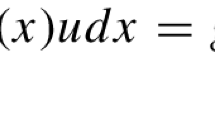For the purpose of development of a new high-accuracy method of separation of variables, allowing one to effectively use the method of differential transformations in combination with the method of weighted residuals, by the example of the problems on the nonstationary heat conduction of an unbounded plate, an unbounded cylinder, and a sphere with the first-kind boundary conditions, a critical analysis of the known solution technique based on the combined use of the Fourier method of separation of variables, the method of differential transformations, and the method of weighted residuals has been performed. It is shown that the computational scheme realized with the indicated technique has a very low approximation accuracy, especially in the case where it is used for bodies of cylindrical and spherical symmetry. The main reasons for the low accuracy of the solutions obtained by this scheme were revealed.
Similar content being viewed by others
References
A. V. Luikov, Theory of Heat Conduction [in Russian], Vysshaya Shkola, Moscow (1967).
H. S. Carslaw and J. C. Jaeger, Conduction of Heat in Solids [Russian translation], Nauka, Moscow (1964).
M. N. Özisik, Heat Conduction, Wiley, New York (1993).
J. W. Brown, Fourier Series and Boundary Value Problems, McGraw-Hill, New York (1993).
M. A. Pinsky, Partial Differential Equations and Boundary-Value Problems with Applications, Waveland Press, Rhode Island (2003).
D. L. Powers, Boundary-Value Problems and Differential Equations, Elsevier Academic Press, Burlington (2006).
E. A. Vlasova, V. S. Zarubin, and G. N. Kuvyrkin, Approximate Methods of Mathematical Physics [in Russian], Izd. MGTU im. N. É. Baumana, Moscow (2001).
F. B. Hildebrand, Methods of Applied Mathematics, Prentice-Hall, New Jersey (1965).
C. A. J. Fletcher, Numerical Methods Based on the Galerkin Method [Russian translation], Mir, Moscow (1988).
L. V. Kantorovich and V. I. Krylov, Approximate Methods of Highest Analysis [in Russian], Gostekhizdat, Moscow–Leningrad (1962).
M. G. Kogan, Solution of nonlinear problems of the theory of heat conduction by Kantorovich method, J. Eng. Phys. Thermophys., 11, No. 1, 38–44 (1967).
V. A. Kudinov, Method of coordinate functions in nonstationary heat-conduction problems, Izv. RAN, Énergetika, No. 3, 82–101 (2004).
V. A. Kudinov, B. V. Averin, and E. V. Stefanyuk, Heat Conduction and Thermoelasticity in Multilayer Constructions [in Russian], Vysshaya Shkola, Moscow (2008).
É. M. Kartashov, V. A. Kudinov, and V. V. Kalashnikov, Theory of Heat and Mass Transfer: Solution of Problems for Multilayer Constructions [in Russian], Yurait, Moscow (2019).
P. V. Tsoi, Development of hybrid analytical-numerical methods of calculating heat and mass transfer, J. Eng. Phys. Thermophys., 59, No. 3, 1103–1110 (1990).
P. V. Tsoi, System Methods of Calculating Boundary-Value Problems on Heat and Mass Transfer [in Russian], Izd. MÉI, Moscow (2005).
S. G. Mikhlin, Variational Methods in Mathematical Physics [in Russian], Nauka, Moscow (1970).
S. G. Mikhlin and Kh. L. Smolitskii, Approximate Methods of Solving Differential and Integral Equations [in Russian], Nauka, Moscow (1965).
G. M. Fichtengolz, Course of Differential and Integral Calculus, Vol. 2 [Russian translation], Fizmatlit, Moscow (1970).
G. I. Marchuk, Methods of Computational Mathematics [in Russian], Nauka, Moscow (1977).
G. E. Pukhov, Taylor Transforms and Their Use in Electrical Technology and Electronics [in Russian], Naukova Dumka, Kiev (1978).
G. E. Pukhov, Differential Transformations of Functions and Equations [in Russian], Naukova Dumka, Kiev (1980).
J. K. Zhou, Differential Transformation and Its Applications for Electrical Circuits, Huazhong University Press, China, Wuhan (1986).
C. K. Chen and S. H. Ho, Application of differential transformation to eigenvalue problems, Appl. Math. Comput., 79, Nos. 2–3, 173–188 (1996).
C. L. Chen and Y. C. Liu, Solution of two point boundary value problems using the differential transformation method, J. Optim. Theory Appl., 99, No. 1, 23–35 (1998).
F. M. Fedorov, Boundary Method of Solving Applied Problems of Mathematical Physics [in Russian], Nauka, Novosibirsk (2000).
Author information
Authors and Affiliations
Corresponding author
Additional information
Translated from Inzhenerno-Fizicheskii Zhurnal, Vol. 93, No. 4, pp. 977–995, July–August, 2020.
Rights and permissions
About this article
Cite this article
Kot, V.A. Combined Method of Separation of Variables. 1. Critical Analysis of the Known Approach. J Eng Phys Thermophy 93, 944–961 (2020). https://doi.org/10.1007/s10891-020-02195-4
Received:
Published:
Issue Date:
DOI: https://doi.org/10.1007/s10891-020-02195-4




